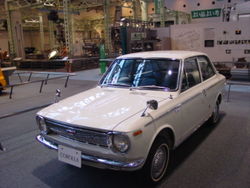Toyota Corolla
Toyota Corolla is the model designation for a passenger car of the lower middle class, later the compact class, which has been used by the Japanese Toyota Motor Corporation since mid-1966 for a number of different passenger car models.
From the Corolla, the factory has derived a number of different variants over time, often limited to Japan and serving the purpose of serving the manufacturer's various distribution networks. Among the best known are the Corolla Sprinter (higher-spec version) introduced in the summer of 1968, the Corolla Levin (coupe versions) and the Sprinter Trueno (the rear-wheel-drive coupe version of the Corolla E70). Most recently, the Corolla Verso minivan was added to the lineup.
While the Corolla was withdrawn from the main European markets (Germany, France, Italy, UK) in spring 2007 in favour of the Auris, the model range continues to be marketed as the Corolla in other markets in Europe and other continents. At the end of 2006, the tenth generation Corolla (E14) was introduced, available in a notchback variant (in Japan: Corolla Axis) and as an estate (Corolla Fielder).
Since 2019, the Toyota compact car is again sold worldwide as Corolla. The corresponding generation was presented at the 2018 Geneva Motor Show still as Auris, later Toyota announced the discontinuation of the model name. In 2020, the Toyota Corolla Cross sport utility vehicle based on this generation was introduced.
Over the course of the model's history, passenger cars bearing the Corolla name were manufactured not only in Japan but in numerous other countries, including the USA, Canada, Brazil, Venezuela, China, Taiwan, Malaysia, Bangladesh, Pakistan, Turkey, Thailand, India, the UK and the Philippines. In a joint venture with General Motors, the Chevrolet Nova and Chevrolet and Geo Prizm, based on the Corolla, were manufactured in California. Also related to the Corolla was the Charmant from Daihatsu, a manufacturer belonging to the Toyota group.
About 46 million Corolla were produced by 2019.

The current Corolla generation is produced as a sedan, station wagon and hatchback.
General
The Toyota Corolla is the best-selling car in the world. However, it has gone through ten model generations, some with fundamental conceptual changes such as the switch from rear-wheel to front-wheel drive. Several times, previously independent models were also integrated into the Corolla range.
The Corolla is considered a very reliable car, which is also confirmed by breakdown statistics and the TÜV reports.
Corolla (E10, 1966-1970)
| 1st generation | |
| Toyota Corolla | |
| Production Period: | 1966–1970 |
| Body versions: | Sedan, station wagon, coupé |
| Engines: | Petrol engines: |
| Length: | 3845 mm |
| Width: | 1485 mm |
| Height: | 1380 mm |
| Wheelbase: | 2285 mm |
| Tare weight: | 710 kg |
In May 1966, Toyota presented the Corolla as an additional model between the Toyota 800 (the forerunner of the Toyota Starlet) and the Toyota Corona, initially as a two-door sedan. This was followed in August 1967 by the four-door sedan and the three-door station wagon, and in August 1968 by a hatchback coupe called the Corolla Sprinter. From the beginning of 1969, more powerful variants of the two-door models were added to the range in the form of the Corolla SL.
The Corolla's technology consisted of a rigid axle on leaf springs at the rear, a front suspension strut axle, rear-wheel drive and a short-stroke inline four-cylinder engine that drew 60 or (in the higher-compression SL) 73 SAE hp (44/54 kW) from 1077 cm³. In the autumn of 1969 the displacement was increased to 1166 cm³, raising power to 65 (SL: 78) SAE hp.
Corolla exports to the USA, where Toyota had been active since 1958, began at prices starting at 1668 USD in the summer of 1968; an Opel Kadett B cost comparatively from 1785 US dollars. In Germany the Corolla E10 was not offered, but in other European countries like Switzerland; there the Corolla cost from 6990 SFr (Kadett 1100: from 6600 SFr). In Japan the new price was 495,000 Yen (about 4500 Euro).
Search within the encyclopedia
